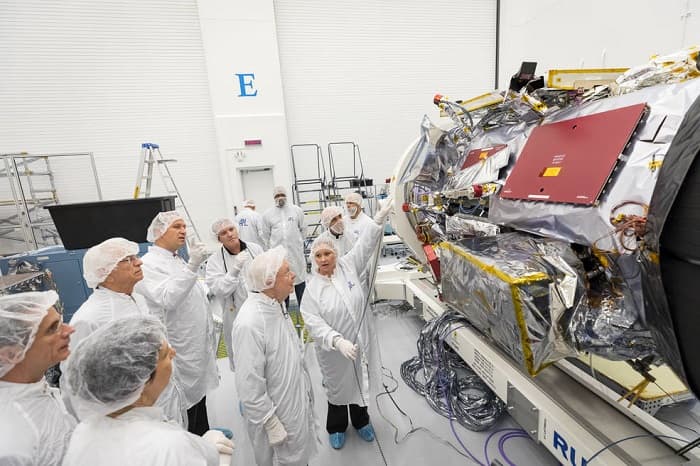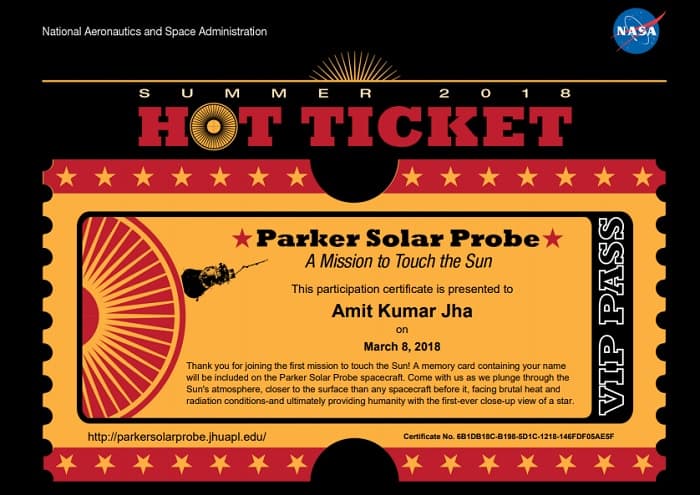Register your name as NASA is inviting people to be a part of its first mission to the Sun
Our Sun - the brightest star of our solar system, is responsible for almost all the lifeforms that sustain on Earth. However, very little is known about this giant ball of fire which is fuelled by the heavy nuclear fusion reaction happening at its core. In the history of mankind, never a spacecraft dared to go near this ball of fire, however, NASA is all set to do the impossible this summer. Parker Solar Probe Mission - which the scientists are eagerly waiting for, will include a spacecraft that will wander the sun 4 million miles away from its surface at a speed of about 430,000 mph. Sounds impossible, isn't it? The interesting thing is NASA is all set to execute this mission with the aim of studying the conditions that prevail during the solar corona. The mission will also look for reasons that drive the powerful solar winds and the energetic particles which come out with it.

Prof. Eugene Parker visiting the NASA Parker Probe at John Hopkins, Applied Physics Laboratory, Maryland
Studying the effects of the Sun on Space and the planetary system is known as heliophysics. Since our Sun is one of the important reasons behind the existence of life in this universe, scientists have been waiting over more than six decades to know the star from upfront. Temperature as high as 2,500 F exists in the region where the spacecraft will wander and thus, the spacecraft will be provided with a protective aid to carry out the sensors and instruments safely. NASA has mentioned that it will aid the spacecraft and the instruments with a 4.5-inch thick coating of the Carbon-Composite shield which will take care of the intensity of heat that will prevail outside the spacecraft.

An artist's rendition of Parker Solar Probe wandering the Sun
The spacecraft had a different name earlier. Recently, its name has been changed to Parker Solar Probe from its previous name Solar Probe Plus to honor the Emeritus Professor Eugene Parker who serves as an astrophysicist at the Department of Astronomy and Astrophysics, University of Chicago. Professor Parker has an immense contribution in the field of heliophysics, especially related to the solar corona and the solar winds. Given the importance of his research and his involvement with this mission, NASA has named its mission for the first time on a living individual.
Apart from all these, NASA is also inviting people to send their names to the Sun along with this mission. Once submitted, the names will be stored on a microchip and will be taken by the spacecraft during the mission. If interested, one can register their name by clicking on this#-Link-Snipped-#and can obtain a certificate like as shown below. The link will be valid until April 27 and one can register their name by using their email id. After registering, one can download the following ticket which will be sent to their registered email ids and can share with their social circle.

A sample ticket issued by NASA when one registers their name with this mission
Overall, Parker Probe mission seems to be full of science and adventure. For scientists, it is more like an achievement to witness the ball of fire from upfront. No doubt, if the mission gets successful, the sensors data will give a huge detail that will help the scientific community to understand the solar corona and the solar winds in a better manner. Solar winds hold the potential to cause a massive solar outage and even has the ability to destroy the lifeform on earth. Given that, the Sun has both the potential to sustain and destroy like on Earth, the importance of this mission is well justified.
Source and Image Credits - #-Link-Snipped-#

Prof. Eugene Parker visiting the NASA Parker Probe at John Hopkins, Applied Physics Laboratory, Maryland
Studying the effects of the Sun on Space and the planetary system is known as heliophysics. Since our Sun is one of the important reasons behind the existence of life in this universe, scientists have been waiting over more than six decades to know the star from upfront. Temperature as high as 2,500 F exists in the region where the spacecraft will wander and thus, the spacecraft will be provided with a protective aid to carry out the sensors and instruments safely. NASA has mentioned that it will aid the spacecraft and the instruments with a 4.5-inch thick coating of the Carbon-Composite shield which will take care of the intensity of heat that will prevail outside the spacecraft.

An artist's rendition of Parker Solar Probe wandering the Sun
The spacecraft had a different name earlier. Recently, its name has been changed to Parker Solar Probe from its previous name Solar Probe Plus to honor the Emeritus Professor Eugene Parker who serves as an astrophysicist at the Department of Astronomy and Astrophysics, University of Chicago. Professor Parker has an immense contribution in the field of heliophysics, especially related to the solar corona and the solar winds. Given the importance of his research and his involvement with this mission, NASA has named its mission for the first time on a living individual.
Apart from all these, NASA is also inviting people to send their names to the Sun along with this mission. Once submitted, the names will be stored on a microchip and will be taken by the spacecraft during the mission. If interested, one can register their name by clicking on this#-Link-Snipped-#and can obtain a certificate like as shown below. The link will be valid until April 27 and one can register their name by using their email id. After registering, one can download the following ticket which will be sent to their registered email ids and can share with their social circle.

A sample ticket issued by NASA when one registers their name with this mission
Overall, Parker Probe mission seems to be full of science and adventure. For scientists, it is more like an achievement to witness the ball of fire from upfront. No doubt, if the mission gets successful, the sensors data will give a huge detail that will help the scientific community to understand the solar corona and the solar winds in a better manner. Solar winds hold the potential to cause a massive solar outage and even has the ability to destroy the lifeform on earth. Given that, the Sun has both the potential to sustain and destroy like on Earth, the importance of this mission is well justified.
Source and Image Credits - #-Link-Snipped-#
Replies
-
 Ramani AswathThanks.
Ramani AswathThanks.
Our Sun is the only star in our solar system. -
 Vinay JakkulaThis is interesting.😀
Vinay JakkulaThis is interesting.😀 -
 Kaustubh KatdareIndeed. I'm more curious to understand the thermal protection this spacecraft will need. Wondering if they're planning to capture photographs as well.
Kaustubh KatdareIndeed. I'm more curious to understand the thermal protection this spacecraft will need. Wondering if they're planning to capture photographs as well. -
 Ramani AswathDoing an order of mag calculation, at 150 million miles our Earth is about 37.5 times farther than the probe will be at 4 million miles. So the solar irradiation will be higher on the probe by the square of 37.5, which comes to about 140 W/Sq.cm.
Ramani AswathDoing an order of mag calculation, at 150 million miles our Earth is about 37.5 times farther than the probe will be at 4 million miles. So the solar irradiation will be higher on the probe by the square of 37.5, which comes to about 140 W/Sq.cm.
For comparison the domestic gas stove flame has an energy density of about 40 W/Sq.cm.
You are reading an archived discussion.
Related Posts
A Bright Future Awaits Prospective Robotics Engineers
3D Printing Tips and Tech: What You Need to Know about 3D Printing
Is digital marketing training in Gurgaon, provided by the company Current Repairs is worth of it. You can share your valuable feedback about the company course curriculum and the internship...
See it in your way but a bone injury, especially a fracture or broken bones is one of the most regular incidents among orthopedic issues. As per Schwebel, Goetz &...
When you hear the term augmented reality (AR) you think of technology that can superimpose digital information over real world visuals. AR has been implemented on smartphone apps and smart...
